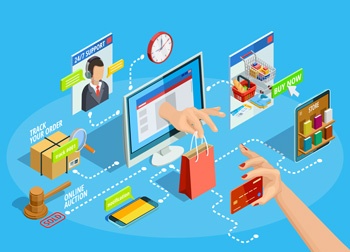As many of us rushed to find just the right gifts and have them in-hand in time for our holiday gatherings this year, we experienced first-hand the importance of retail stores in the overall omnichannel order fulfillment experience.
In some cases, after ordering online and opting to pick up in store, everything went smoothly and we had what we needed in-hand quickly, as expected. Wonderful! Everyone’s happy, right? (Unless your gift recipient is just that impossibly picky).
In other situations, we waited in long lines to pick up our orders or stood frustrated at the customer service desk as a frazzled store associate struggled to locate an item we ordered online for pickup in-store.
Omni-channel Customer Experience
When I experienced this last week, it seemed that the retailer’s online inventory information didn’t reflect reality, and there was no indication of a problem until I arrived to pick up my order. After 30 minutes of watching multiple store associates making phone calls, getting help from managers, and running around the store looking for misplaced inventory, I had to cancel my purchase and found another retailer that had what I needed. It may be a while before I choose the “Buy Online, Pick up in Store” (BOPIS) option from that retailer again.
Sound familiar? I hope not, but chances are, you have dealt with this type of frustration at some point. Let’s explore the good and the bad of the in-store experience in Omnichannel, and why store enablement is so important.
These days, we have come to expect a timely, seamless order fulfillment experience no matter what channel, and that means more than just the ability to ship to or ship from stores.
IBM Institute for Business Value
Consider this: the 2017 Consumer Experience Index (CEI) study by the IBM Institute for Business Value revealed that while “Buy Online, Pick up in Store” (BOPIS) is sharply gaining popularity, 38% of brands do not offer a click and collect service, and only 26% are able to provide BOPIS within a half day after purchase.
When it comes to inventory accuracy, while the study indicates that 36% of brands can offer consumers consistent (though basic) inventory data, the results suggested that consumers do not have—or cannot rely on—cross-channel inventory data to help make buying decisions. 30% of brands offer inconsistent or no supply chain data at all, and a further 17% are unable to guarantee against missing inventory data across channels.
As for interactions with store associates, the study revealed that 79% of brands either do not have mobile-enabled associates or do not provide their associates with mobile access to customer information.
It’s clear that the store plays a critical role in the omnichannel consumer experience and in differentiating brands. According to the CEI study, leaders outperform laggards most significantly in the areas of store experience, personalization, and physical/digital integration.
The Enablers
In addition to leveraging an omnichannel order management solution (OMS) that ensures accurate cross-channel inventory visibility, enables BOPIS and other fulfillment options, optimizes fulfillment and delivery, and equips store and customer service associates with customer and order information—retailers should invest in store enablement to optimize the omnichannel consumer experiences.
Not only do store associates need to be able to fulfill and ship online orders, but they must also be able to help customers in the store locate and order items, and prioritize online order fulfillment.
The store—and, in particular, the store associates—need to have tools that can help them with these tasks. Given that the typical store associate is a young, relatively inexperienced, short-term employee (like a college student) these tools for store enablement also have to be intuitive so that the training period is minimal. Only then can they help with—and enhance—omnichannel experience.
Avoid Online Out-of-Stock Situations
Store enablement is critical to avoid online out-of-stock situations. One of the first things that comes to mind with omnichannel commerce is fulfilling orders from stock that is already in-store. However, this involves more than just fulfilling the order from the nearest retail location to the customer. Companies should leverage data to choose the best location, such as a nearby location that has an overstock of the item or a location that normally doesn’t carry the item but received one as a return. This should be balanced with the urgency for the consumer as well as shipping time and costs.
Empower Store Associates to Find Items at Other Locations
According to an IBM study, 81 percent of consumers said it was important for store associates to find out of stock items at in-stock locations and have the item shipped to them. Instead of waiting while the store associate makes phone calls to nearby stores, they want the store associate to quickly access inventory and say, “Yes, we do have that item in our Springfield location. I can either have that shipped directly to you or put it on reserve for you to pick it up.”
Consider this experience: Madison is shopping for a particular sweater at a retail store. She finds one in another size and is pleased with how the color looks on her, but the store doesn’t have any of her size stock. The store associate can place Madison’s order on a tablet and have the item shipped directly to her doorstep with two-day shipping.
Prevent Stores from Being Overwhelmed with Order Fulfillment
Store enablement also extends to what stores can handle when fulfilling online orders. For example, an item may be in stock at a particular location, but it’s also in high demand at that location. It may be best to fulfill from a different location where the demand is lower but the shipping time and cost to get to the consumer would be basically the same.
In another scenario, a store can only handle fulfilling so many online orders per day. Stores need to be able to set thresholds so that, in these cases and others, store associates don’t become so busy with fulfilling online orders that they end up neglecting in-store customers.
Saving the Sale
In some cases, customers will know about complementary or special items carried online but not in store, or they’ll be looking for a particular product that is sold out in their size or other preference. A “Save the Sale” option for store associates provides them with the option to find the out-of-stock item elsewhere or find the complementary or alternate items quickly. The store associate can also view promotions on the item, as well as accessories, loyalty program rewards, or other offers that not only ensures a seamless and consistent experience across channels, but can lead to an upsell or cross-sell opportunity as well.
Visibility for Store Managers
Another important part of store enablement is providing insights for store managers. This can come in the form of what’s being shipped, how many orders are being fulfilled, and the overall effect on store sales. It can also alert store managers to items that are in danger of not meeting their ship times so that these can be prioritized.
With these capabilities, retail locations can play a very positive and impactful role in delivering a truly seamless omnichannel experience. The retail store becomes an extension of the online store, and vice versa.
Your Turn
What are your great—or perhaps your terrible—experiences associated with BOPIS, digital-store channel integration, or store enablement capabilities?
Also, feel from to contact us to learn how we can help you leverage omnichannel order management and store enablement to improve your retail experience.

